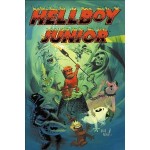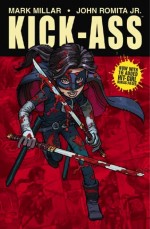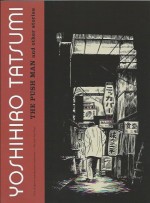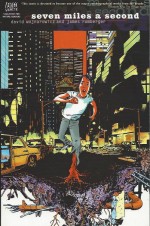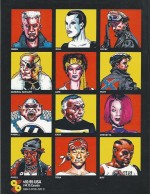
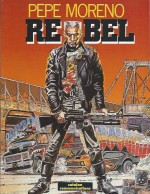
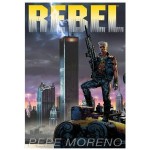
By Pepe Moreno & others (Catalan Communications/IDW)
ISBN: 978-0-87416-020-8 (1986)Â Â Â Â Â 978-1-60010-495-4 (2009)
Born in 1954, Spanish creator Pepe Moreno began his comics career, illustrating for horror and adventure anthologies and children’s papers such as S.O.S., Pumby and Pulgarcito, Star and Bliz.
He moved to America in 1977, briefly working for Jim Warren’s Creepy, Eerie 1984/1994 and Vampirella titles, as well as humour magazine National Lampoon before gravitating to Heavy Metal where his short, uncompromising post-punk strips (collected in the album Zeppelin) caught the attention of Epic Illustrated editor Archie Goodwin.
The breakthrough strip Generation Zero led to the graphic novel Rebel, as well as successor’s Joe’s Air Force and Gene Kong, but ever-restless, Moreno’s growing fascination with technology led him first into animation (Tiger Sharks, Thunder Cats and Silver Hawks) and eventually into the budding, formative field of computer illustration, resulting in a return to comics for the high-profile computer-generated futuristic Batman thriller Digital Justice.
He created an early CD-ROM thriller with Hellcab in 1993 and, these days, spends most of his time working in high-end video games.
Imagined and executed in the politically contentious and conservative mid-Eighties when dystopian dreams of fallen empires abounded and post-apocalyptic survivalism was the prevailing zeitgeist, Rebel – conceived and illustrated by the Spaniard and scripted by English-speakers Robb Hingley, Pete Ciccone & Kenny Sylvester (with an additional tip of the hat to Charis Moe) depicted, in a blaze of pop-art style and colour a future that never came…
2002AD: when Rockabilly gangs, Mohawks, Asian Zeros, Skinheads and a dozen other fashion-punks tribes warred and raced weaponised Hot-rods amidst the fallen skyscrapers of New York, whilst the authorities in absentia used their draconian Sanitation Police to cleanse the streets of young scum…
After a second Civil War and the fall of American civilisation, “decent†men and women retreated to purpose-built Cosmo City and left the Big Apple to rot. Now, decades later, gangs scavenge the shambles for food, tech and fuel for their hybridised, customised vehicles whilst the new civilisation’s fascistic forces attempt to re-establish order. However Sanitation Police commander Major Kessler, working closely with decadent Skinhead overlord Doll, is hiding a dark secret: every deviant captured either ends up a gladiator in slave games or spare-parts for a thriving organ-legging racket to extend the worthless lives of the elite of Cosmo…
After another destructive drag race through the streets, a number of gangers are arrested under the spurious “Social Hygiene Act†but a hidden sniper quickly and efficiently despatches the smugly murderous cops. The grateful bad boys have been saved by a legendary urban warrior – Rebel…
The mystery man has built a close-knit team from his base in Brooklyn and, when a supply run to scavenge food, fuel and beer leads to a pitched street battle with rival Black Knights, the scabrous Doll points out the hero to his paymaster with a scheme to end the charismatic leader’s resistance.
Kessler, however, recognises an old friend and deduces Rebel’s true identity…
Even as the assorted gangs fruitlessly and perpetually battle each other, Rebel is trying to organise a concerted resistance to the Cosmo City invaders. As well he might, since years ago when they were an honest army of liberation, he was one of their greatest soldiers.
Once the war was over and the victors became as bad as the oppressors they had overturned, the disillusioned and dangerous Lt. Lawrence disappeared and Rebel was born…
As Kessler organises a massive armed response in New York to ferret out the traitor, Rebel springs a brilliant tactical attack and decimates the Sanitation Police forces. In the aftermath, subversives from Cosmo approach him, begging the forgotten warrior to return and overturn the corrupt government of the austere super-city…
However, when the troubled Rebel returns to his Brooklyn base, he finds a scene of torture and carnage. Doll and his savage minions have destroyed the citadel and taken Lawrence’s lover Lori hostage.
Chained naked to the spire of the single remaining tower of the ancient World Trade Center, she is helpless, tantalising bait which Rebel cannot resist. Even so, not only must the living legend storm a tower filled with brutal thugs who hate his guts, but unknown to all, Kessler has engaged an entire division of helicopter gunships to eradicate the inspirational leader’s threat forever…
But the Rebel has a plan. A bold, spectacular impossibly dangerous plan…
Mythical, ultra-violent and rather nonsensical in strictly logical terms, Rebel is a powerful and exuberant paean to the fashions, memes and visual tropes of that tumultuous era, moulding social fantasy and grinding realpolitik into a graphic rollercoaster ride that combines the grimy meta-reality of Mad Max and Escape from New York with the gaudy, glitzy flourish of Xanadu and the dour stylish pessimism of Brazil.
In 2009 IDW and Digital Fusion released a remastered and expanded edition in a reduced page size (260x165mm as opposed to the original’s 269x208mm album format) with computer-enhanced colour that sadly sacrificed much of the vivid, pinball and poster hues which made the original such a quirky treat, but as both are still readily available online, one quick look at the teaser art for each should enable you to pay your money and make your preferred taste choice…
© 1986 Pepe Moreno. English language edition © 1986 Catalan Communications. All rights reserved.




